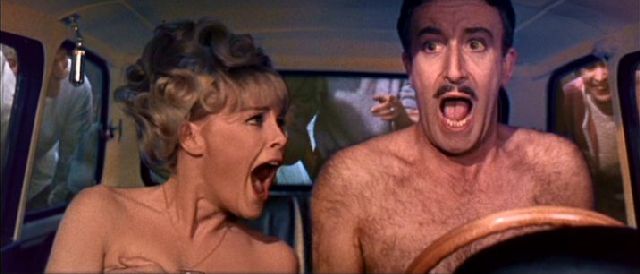A Shot in the Dark (1964) 
“… The Picture That Gets Away With Murder!”

Director: Blake Edwards
Cast: Peter Sellers, Elke Sommer, George Sanders
Synopsis: When a widow’s husband gets murdered in cold blood, Inspector Clouseau is back on the job leaving Maria, the widow to be the suspect. However, Clouseau struggles the overwhelming evidence as the true suspect is still out there.
Watch this and other movies on Sky Cinema
If there’s any clue to the fact that A Shot in the Dark was a hurriedly-made sequel to hit movie The Pink Panther, it’s in the inchoate murder plot rather than the quality of the comedy. Adapted by its director Blake Edwards and a young William Peter Blatty of The Exorcist fame from a stage play to which it bears almost no resemblance, the murder mystery in A Shot in the Dark is nothing more than a framework around which Clouseau wreaks his usual havoc.
A Shot in the Dark opens with a long crane shot following a series of illicit nocturnal sexual liaisons on the grounds of Benjamin Ballon’s (George Sanders — A Touch of Larceny, The Kremlin Letter) stately home which culminates in a gunshot and one dead chauffeur. Seeing as young maid Maria Gambrelli (Elke Sommer) is found over the body holding a smoking gun, it’s only reasonable to assume that she is the murderess. But Inspector Clouseau (Peter Sellers — Dr. Strangelove), who has mistakenly been assigned to the case, suspects that she has been framed, for no other reason than he has become instantly besotted by the fetching young maid. Fully aware of Clouseau’s incompetence, his superior officer, Charles Dreyfus (Herbert Lom — Assignment to Kill) takes the bumbling detective off the case — but is soon forced to reinstate him on the orders of an undisclosed observer.
Clouseau may well be bumbling — and he’s also pompous and self-important — but the truth is his theories in A Shot in the Dark are always spot on, a fact which leads to great mental torture for Dreyfus, whose sanity slips by such degrees that by the end of the movie he’s snarling like a dog as he gnaws at Clouseau’s ankles (trust me, it’s funnier than it reads). If it wasn’t for the presence of Sellers, Lom would steal the picture by a country mile, but he simply can’t compete with a comic who was at the top of his game. Too often, directors would indulge Sellers whims, allowing him to extend comic routines beyond their natural life-span until he had squeezed the life out of them, but Edwards’ skill at directing comedies saw him rein in Sellers’ natural tendencies, which was perhaps why they tended to clash when working together. However, both men knew they brought out the best of one another on the screen and would work together a further five times.
The comedy in A Shot in the Dark is screamingly funny at times. Although Clouseau would become a caricature in the later Panther movies, he was merely an accident-prone buffoon with an exaggerated sense of his own abilities here, who was helpless in the grip of his overwhelming need to impress everyone with whom he came into contact. He was pathetic, but in a recognisable way that won the audience’s sympathy and therefore made the scrapes in which he found himself all the more hilarious. There are many comic highlights in A Shot in the Dark — the scene in which Clouseau prowls the corridor outside his office as he anxiously waits for Maria Gambrelli to be brought in for questioning is unforgettable — but for me, the movie’s funniest moment, a moment which approaches comic genius, is the scene in which Clouseau momentarily breaks the fourth wall to stare at the audience in total frustration as the suspects he gathered for the big reveal, repeatedly ignore his queries — ‘what?… what?’ — as they loudly accuse one another of the various murders. By far the best of the Panther movies, A Shot in the Dark is a comedy that shouldn’t be missed.
(Reviewed 6th April 2014)
httpv://www.youtube.com/watch?v=v8K1e2hxqs4
